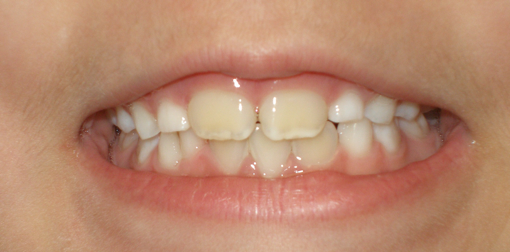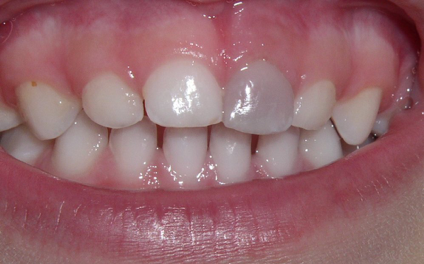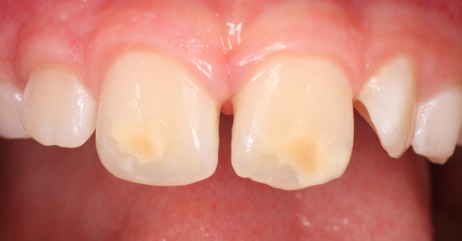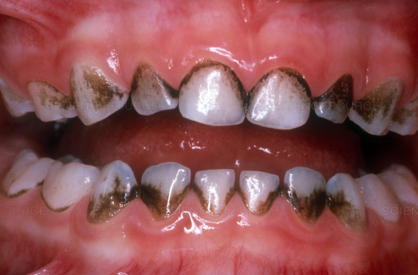Disclosure :: This post is sponsored by Lafayette Pediatric Dentistry and authored by local mom & dentist, Dr. Anita Gouri. Even if discolored teeth is NOT an issue in your home, Dr. Gouri highly recommends that you consider seeing a pediatric dentist by age one.
The Most Common Causes of Discolored Teeth
 “My child’s teeth are discolored. What does this mean?”
“My child’s teeth are discolored. What does this mean?”
Tooth discoloration happens for a variety of reasons, which generally belong to one of two categories:
- External—where the discoloration is more superficial, on the enamel
- Internal—where the discoloration is coming from within the deeper layers of the tooth (dentin, pulp)
Perhaps the most common complaint I hear in my office regarding discolored of the teeth is “No matter how hard we brush, her teeth still look yellow!”

That’s because discoloration of teeth is a natural occurrence. Permanent teeth are naturally yellower than baby teeth. When your child is in the “mixed dentition” phase, where their front baby teeth have fallen out but the baby molars remain, the contrast makes the color of the new permanent teeth especially unappealing. Once more baby teeth fall out in the back, it does not look so “yellow” anymore.
Another common cause of intrinsic discoloration is trauma.

When a tooth is bumped or injured, it can subsequently turn dark yellow or grey. Sometimes this discoloration improves over time, other times it remains. The important thing is to make sure a pediatric dentist sees your child right away to rule out a dental abscess, which is a common occurrence after dental trauma.
Plenty of people have congenital “blemishes” or spots on their front teeth like these:

This condition is known as enamel hypoplasia. It occurs due to a disturbance in the formation of the tooth, resulting in a yellowish-brown discoloration. The cause is often unknown, but can be linked to high fevers, antibiotics, or medications as an infant. Unfortunately there is no way to prevent it, but your pediatric dentist can remove or mask the discoloration!
Rarer causes of intrinsic staining include fluorosis, where too much fluoride intake causes mottled white discoloration, or the less common blue/green/grey tetracycline staining, which is an antibiotic that is not as frequently administered these days for this reason. These conditions are much harder to mask and require more involved, multi-step approaches by a cosmetic dentist.
Extrinsic stains, where an outside substance discolors the teeth, are usually removable during a cleaning.

The most common culprits of extrinsic staining and discolored teeth in older individuals include Coke, coffee, tea, and tobacco products. When seen in children, the cause can be more obscure. Frequently, children who are on multivitamins containing Iron will develop a dark stain on their teeth.
If there is no iron in the vitamin, then the staining is most likely due to chromogenic (color-creating) bacteria in the mouth that create the discoloration, staining the plaque dark brown to even “Cheeto”-orange! Fear not, a thorough professional cleaning by your pediatric dentist can remove these stains.
As always, don’t forget that thorough, regular brushing and flossing (click here for recommended toothbrushes and toothpaste) at home is instrumental in removal of daily buildup of tartar and plaque, which traps stain on your teeth.
Make sure you visit your pediatric dentist twice yearly to get the more stubborn stuff cleaned off!
For more information on Lafayette Pediatric Dentistry or Dr. Anita Gouri visit the links below OR call the office at (337) 443-9944 and set up your first consultation for FREE.
Website | Facebook | Instagram | Twitter
Other Dental Related Topics that May Be of Interest ::
- Why Does My Child Have White Spots on Their Teeth?
- What if My Kid Freaks Out at the Dentist?
- Tips on Weaning Your Little One From Thumb & Finger Sucking
- Sleep Disordered Breathing: More Common Than You Think!
- Why Take X-Rays Routinely at the Dentist?
- Teething Toddler Woes: Tips and Tricks For Relief
- The Most Common Causes of Cavities
- Four Reasons Moms Should Reconsider Fruit Snacks
- The Truth About Tongue and Lip-Ties
About the Author
 Dr. Anita Gouri, a pediatric dentist, has been practicing in Lafayette for 10 years and is the owner of Lafayette Pediatric Dentistry. She graduated from LSU School of Dentistry in 2006, receiving honors including Outstanding Achievement in Pediatric Dentistry, Honors in Research, and the Carl A. Baldridge Academic Scholarship. She completed her residency in pediatric dentistry at Children’s National Medical Center in Washington DC in 2008 and became a board certified diplomate of the American Board of Pediatric Dentistry in 2009. In 2010, her research on dental pain assessment was published in Pediatric Dentistry. She also has specialized training in treating babies and children who have tongue and lip ties. She is a member of the Academy of Laser Dentistry, American Academy of Pediatric Dentistry, the Louisiana Dental Association, the Southwestern Society of Pediatric Dentistry, American Dental Association, as well as the C. Edmund Kells and Omicron Kappa Upsilon Dental Honor Societies. Dr. Gouri, her husband, and their two children enjoy travel, Saints football, good food and good friends.
Dr. Anita Gouri, a pediatric dentist, has been practicing in Lafayette for 10 years and is the owner of Lafayette Pediatric Dentistry. She graduated from LSU School of Dentistry in 2006, receiving honors including Outstanding Achievement in Pediatric Dentistry, Honors in Research, and the Carl A. Baldridge Academic Scholarship. She completed her residency in pediatric dentistry at Children’s National Medical Center in Washington DC in 2008 and became a board certified diplomate of the American Board of Pediatric Dentistry in 2009. In 2010, her research on dental pain assessment was published in Pediatric Dentistry. She also has specialized training in treating babies and children who have tongue and lip ties. She is a member of the Academy of Laser Dentistry, American Academy of Pediatric Dentistry, the Louisiana Dental Association, the Southwestern Society of Pediatric Dentistry, American Dental Association, as well as the C. Edmund Kells and Omicron Kappa Upsilon Dental Honor Societies. Dr. Gouri, her husband, and their two children enjoy travel, Saints football, good food and good friends.


















